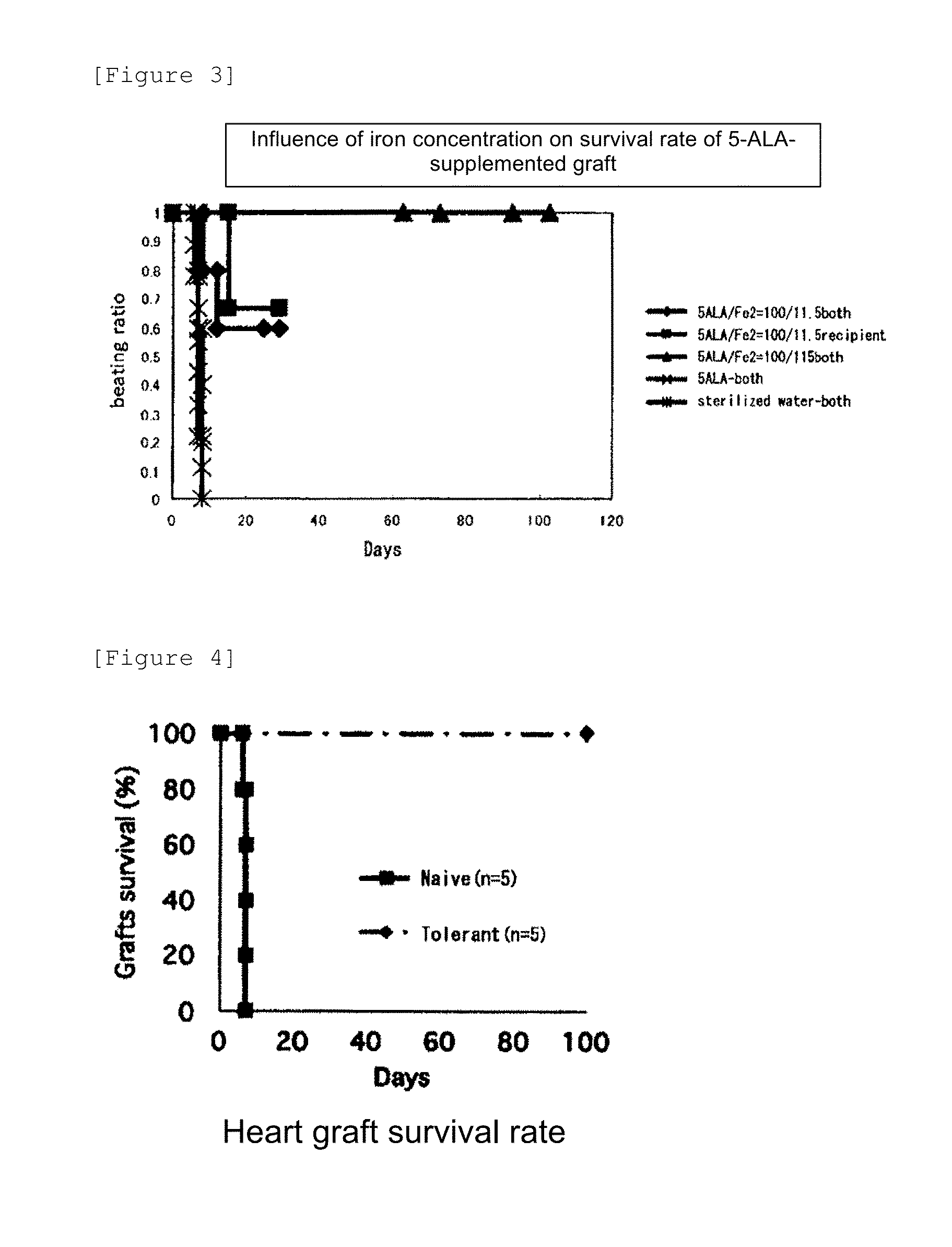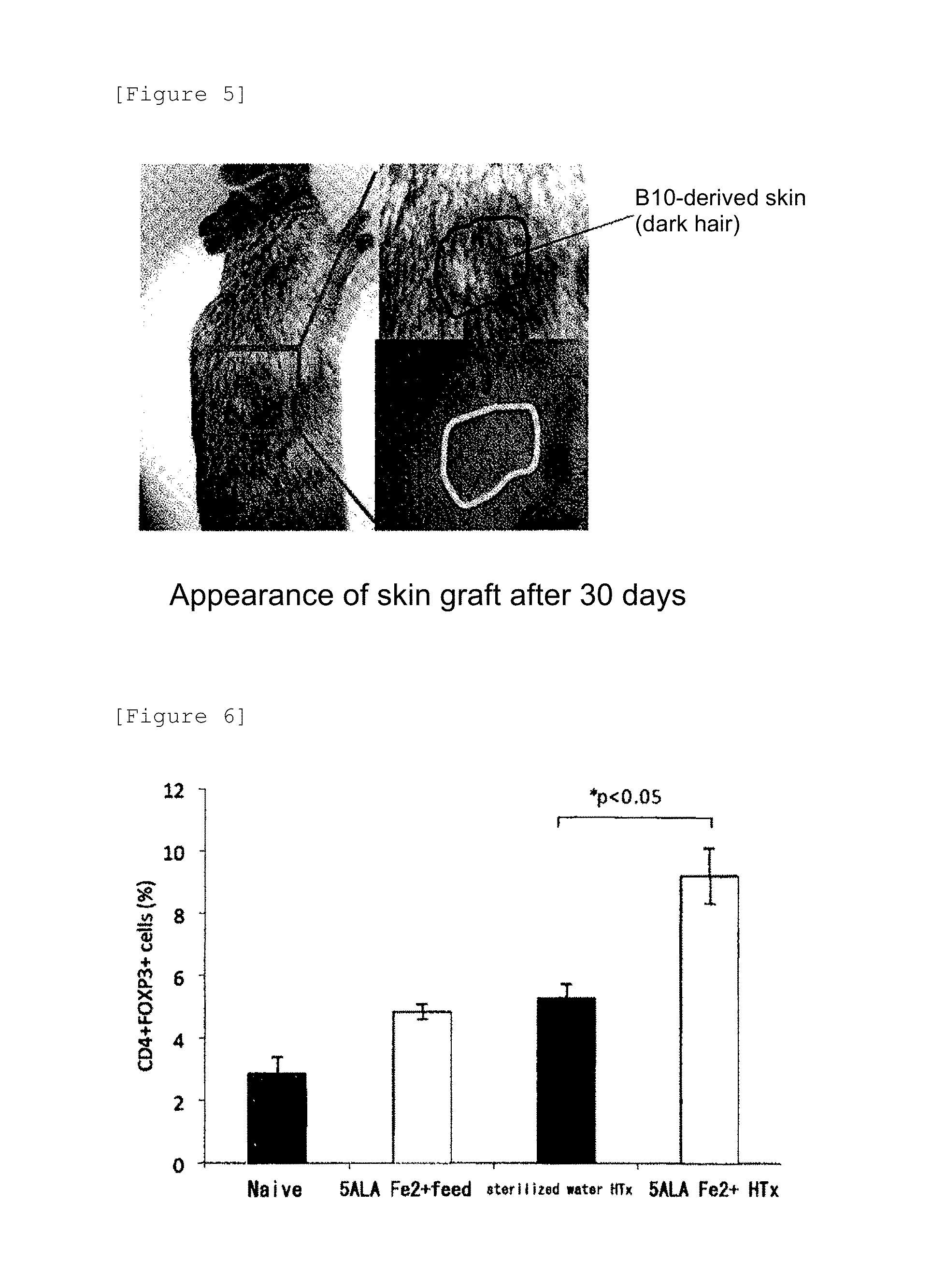Enhancer of survival of transplanted organ
a transplanted organ and survival enhancer technology, applied in the direction of antinoxious agents, peptide/protein ingredients, immunological disorders, etc., can solve the problems of renal damage, infection, lymphoid hyperplasia, serious adverse reactions, etc., to promote graft survival, suppress rejection, and maintain freshness
- Summary
- Abstract
- Description
- Claims
- Application Information
AI Technical Summary
Benefits of technology
Problems solved by technology
Method used
Image
Examples
example 1
Preparation of Heterotopic Homologous Heart-Transplanted Model Mice
[0069]B10 mice (male, 10 weeks old on average, body weight: 20 to 25 g) were used as donors for the hearts to be transplanted. CBA mice (male, 10 weeks old on average, body weight: 20 to 25 g) were used as recipients to receive the hearts taken out of the donors. The procedures of the heterotopic homologous heart transplantation in mice followed the description of Experimental Manual of Organ Transplantation (Shujunsha Co., Ltd.), Paragraph 1, Part 2, 2-1-5 “Heterotopic Heart Transplantation in Mice”. Hereinafter, the procedures will be summarized.
[0070]The thorax of each donor mouse was opened under anesthesia and sufficiently perfused using 1 mL of saline supplemented with cold heparin, followed by excision of the heart. The excised heart was preserved in saline supplemented with cold heparin. The abdomen of each recipient mouse was opened under anesthesia, and the heart excised from the donor mouse was transplante...
example 2
Homologous Heart Graft Survival Efficiency in Mice (1)
[0071]The heterotopic heart-transplanted model mice were divided into groups (1) to (4) with administration patterns shown in Table 1 below. An experiment was conducted on the oral administration of the agent for promoting graft survival of the present invention. The test mice took the administration composition and were additionally permitted to freely take diets or water before anesthesia and after recovering from anesthesia. The experiment is summarized in FIG. 1.
TABLE 1Mice inadministrationAdministration compositionAdministration periodGroup (1)Donor mice +Sterilized waterFrom 2 days before excision toControlexcision daten = 6Recipient miceSterilized waterFrom day after transplantation to11th dayGroup (2)Donor miceALA phosphate 100 mg / kgFrom 2 days before excision ton = 6Sodium ferrous citrate 115 mg / kgexcision dateRecipient miceSterilized waterFrom day after transplantation to11th dayGroup (3)Donor miceSterilized waterFrom 2...
example 3
Mechanism of Graft Survival is Based on Immune Tolerance
[0086]ALA (100 mg / kg)+SFC (115 mg / kg) were administered to both donor and recipient mice from 2 days before heart transplantation to the transplantation date and continuously administered after heart transplantation only to the recipient mice once a day until the 11th day. Spleen cells derived from the first transplantation recipient mice (CBA) with long-term graft survival (>100 days) were isolated and intraperitoneally injected into other recipient mice of this strain (CBA) at the same time with the transplantation of the hearts from donor mice (B10) of the same strain as in the first transplantation into the recipient mice of CBA strain. The results are shown in FIG. 4. As a result, the transplantation of the spleen cells that underwent ALA+SFC-administered heart transplantation promoted a graft survival rate after the second heart transplantation (secondary induction of immune tolerance). Specifically, mice (Tolerant; n=5) ...
PUM
 Login to View More
Login to View More Abstract
Description
Claims
Application Information
 Login to View More
Login to View More - R&D
- Intellectual Property
- Life Sciences
- Materials
- Tech Scout
- Unparalleled Data Quality
- Higher Quality Content
- 60% Fewer Hallucinations
Browse by: Latest US Patents, China's latest patents, Technical Efficacy Thesaurus, Application Domain, Technology Topic, Popular Technical Reports.
© 2025 PatSnap. All rights reserved.Legal|Privacy policy|Modern Slavery Act Transparency Statement|Sitemap|About US| Contact US: help@patsnap.com



